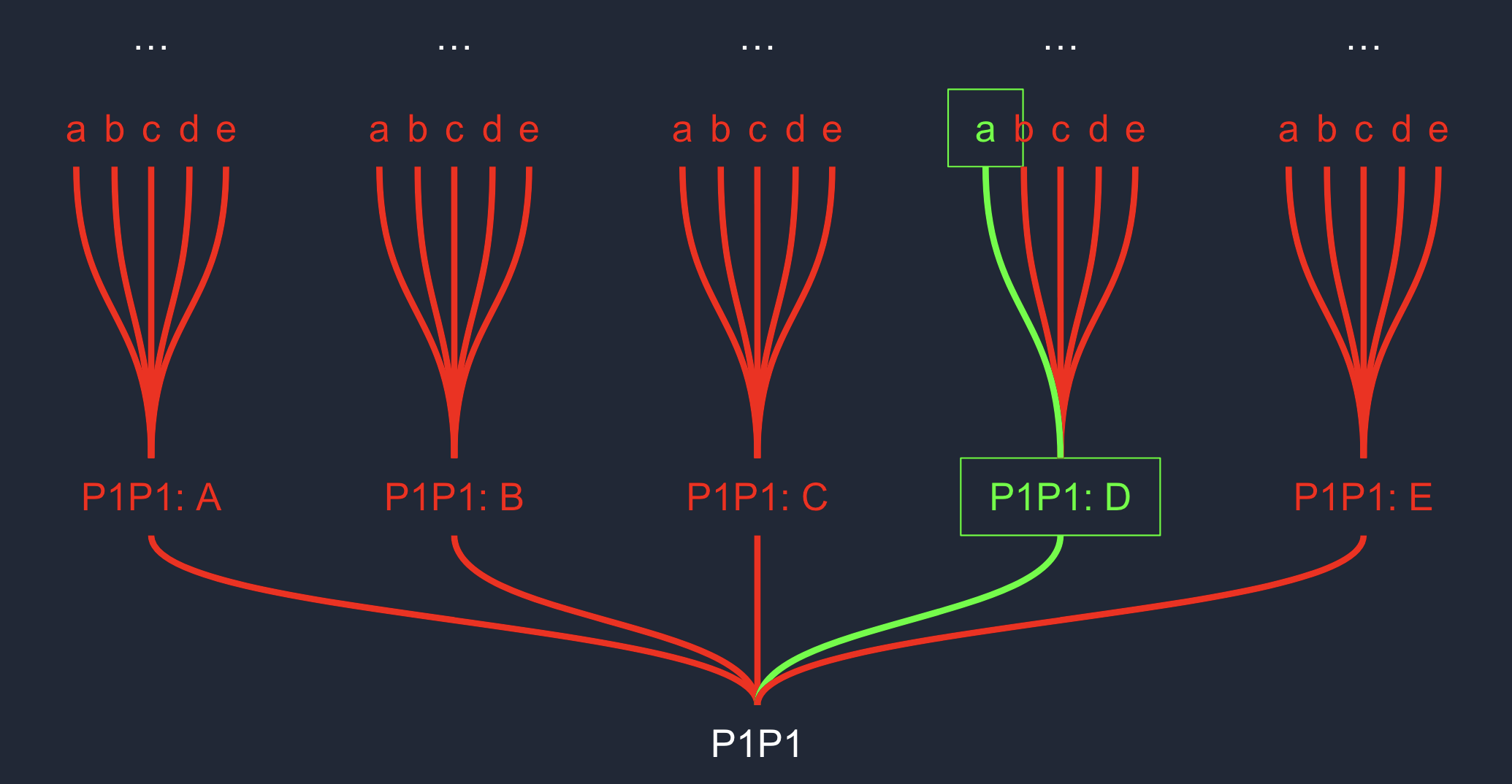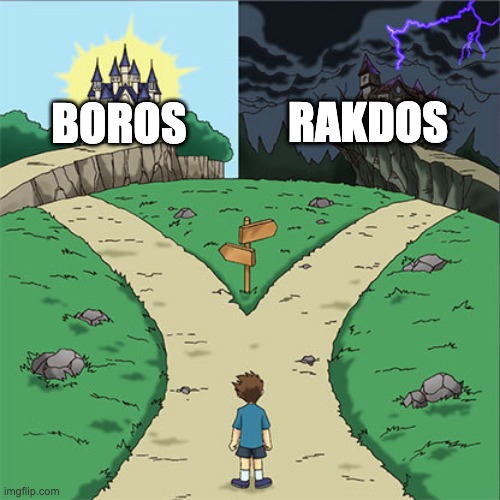The Art of Speculation
08/28/2024
Recently, there was a bunch of discourse amongst Magic pros about the merits of "drafting the hard way". Amongst other discourse: I wrote a Twitter thread, JED wrote a Twitter thread, and PVDDR wrote an article.
The discourse is broadly about Ben Stark's original article, but the real core of the discussion is one specific question:
How often should you speculate, vs staying in your lane?
After reading what many others have to say on this question, it seems that I have a much different perspective on this than most. So, today I figured I'd dive into my approach, in a more organized manner than Twitter can allow for.
To be clear, this article isn't meant as a direct response to Drafting the Hard Way, or PV's article, or anyone really - instead it's simply a portrayal of my philosophy on the art of speculation in draft.
Part 1: Draft Decks, Not Cards
To answer any question about how we should draft, we must first turn to the more fundamental question: "what is our end goal?" And the answer there is simple:
The goal of drafting is to end up with the best deck.
So naturally, when you're drafting, the main consideration of every single pick you make should be: "how does this improve my final deck?"
Cards do not exist in a vacuum. When we talk about card evaluation, it's very common to treat them like they do, because it's simpler that way. We can give cards nice and easy grades like "B-", or "5/10" - however, it's very important to remember that those are merely broad generalizations, and stand-ins for the much wider spectrum of what a card can represent.
Example: Removal
Removal spells are a very common example of how the same cards can perform quite differently in different contexts.
The fact of the matter is that different kinds of decks use removal spells differently. Aggressive decks generally want to use removal to clear blockers; whereas controlling decks generally use cheap removal for defensive speed, and catch-all removal to deal with problematic threats that might take over the game at any point.
All decks appreciate having access to removal to deal with bombs and other high quality cards, but a
cheap, defensively oriented removal spell is going to do worse in an aggressive deck.Part 2: Pick Deck Distributions, Not Cards
To build on that framing, let's zoom out a little, and talk about how I like to view my path through a draft.
Before you begin a draft, you know almost nothing about what your draft will look like. The only thing you have are preconceived notions, based on knowledge you might have of the format - maybe green is good and blue is bad; maybe you have an idea of the best rares, uncommons, and commons; maybe you have opinions on what different archetypes generally look like when built well. These preconceived notions probably give you some distribution of decks you can imagine ending up in.
If you think one color pair is better, you're probably more likely to end up there - maybe you assign 15% of your distribution to decks of that color pair, as opposed to only 5% to the weakest color pair. You probably have some knowledge of how to build decks, so most of the decks in your distribution of possibilities probably try their best to follow a curve and play a good mix of threats and removal. But these are all still heuristics - anything could happen during the draft.
Contrast this to the end of your draft. By then, you have absolutely no uncertainty as to what your deck looks like: your distribution has collapsed to a single pool of cards, from which you will build your deck.
You can visualize this collapsing of uncertainty as a tree, where each pick branches off based on what card you select:

At the beginning of Pack 1 Pick 1, you have the whole possibility space open to you - for all you know, your deck at the end could look like anything. You're at the root of this huge tree of possibilities, and you could go down any branch you'd like. But each pick you make, you lock in a card that will definitely be in your pool at the end of the draft - thus narrowing down what your deck might look like at the end of the draft. By the end, you've chosen exactly one of the leaves of this tree as your final pool.
This concept of each pick locking in part of your pool is one that I find very important. Before the draft, your theoretical deck has the potential to be anything; but with every single pack you see and pick you make, you spend some of that potential, collapsing it into certainty. Once you make a pick, you will always have that card, and you will never get back that potential.
So, when you're making draft picks, you're not just picking between cards to add to your pool. You're picking between different ways to shape the distribution of what your final deck will look like. Each pick is important not just for the card you have, but also for which doors it leaves open and which doors it slams shut.
Example: Filling Out Roles
There are many factors that go into building a good limited deck. Bombs, removal, threats, fixing, a good curve, etc.
One common mistake I see people make in draft is to focus on the perceived generic "power level" of cards, without paying attention to what roles those cards actually fulfill in their deck. Sure, some cards are generally more powerful than others, but the reality is that almost everything in Magic deckbuilding has diminishing returns - you generally want a good mix of cards that play various roles.
So, I often see people wondering how they could possibly have not trophied with so many good rares and other premium cards. The answer is almost always some form of imbalance: an expensive curve, or a lack of removal, or a lack of fixing, or many other things inbetween. And the problem almost always could've been avoided during the draft.
So when you're drafting, you need to make sure to set yourself up for success. Every limited deck starts with a bunch of holes - you don't have enough removal, you don't have enough 2 drops, you don't have enough fixing, etc. etc. A big part of drafting well is learning how to prioritize plugging those holes.
Is this "generically stronger" card better than taking an additional 2 drop? That depends on a lot of factors! How many 2s do you have? How many 2s you're aiming to end up with? Where you are in the draft? How much untapped potential do you have left, and how likely is that to produce the 2s that you need? Which distribution of possible pools is better: the one that branches off from taking the "stronger-in-a-vacuum" card, or the one that branches off from taking the 2 drop?
As a rough guideline, I tend to start thinking about these kinds of "role-filling" problems during pack 2, and really start going out of my way for them during pack 3. But these considerations should always be part of how you draft - locking in a potentially-important role early allows you more flexibility to take better cards later!
Every pick you make has a cost. If you're going to have to pick a certain number of 2s by the end of the draft, figure out when you can do so with minimal cost, so you aren't forced into hard choices when the cost is bigger!
Part 3: Speculate on Deck Distributions, Not Rigid Lanes
When people talk about speculating on picks, it's often phrased in one or both of two ways: speculating on that singular card ("Wow this is a late bomb, I'm going to take it and see if I can play it!"), or speculating on colors ("Wow this color pair seems open, I'm going to try to move into that lane!").
However, in my opinion both of these ways of viewing speculation are flawed, or at least incomplete.
Of course, I've already talked at length about how I think it is a mistake to view cards in a vacuum, so I won't harp on it too much more. But my problem with how people usually treat speculating on "open lanes" is actually quite similar - you shouldn't view lanes in isolation either.

a relevant meme I tweeted out recently
It's just never purely as simple as "XY color pair was open so I moved into that lane." As it turns out, drafting a Rakdos deck starting with your P1P1 is just categorically quite different from drafting a Rakdos deck deck starting P1P2 while also having a white bomb rare; which is again extremely different from drafting a Rakdos deck starting P1P8 with four good white cards in your pool.
Let's consider a somewhat abstract example to help visualize what I mean by this. Say it's Pack 1 Pick 8, and so far you have picked four white cards and three red cards. But when you open your 8th pack, you see no appealing red or white cards - but there is a strong black card in the pack! So you take it. Then, Pack 1 Pick 9 comes around, and you decide to take a strong but narrow Rakdos card (think
Cranial Ram from MH3) over an okay but unexciting white card (think Inspired Inventor).This is a pretty standard pivot, right? White has been drying up a bit, so even though we've started with some Boros cards, we're now recognizing that maybe we instead want to take advantage of this alternate Rakdos path.
But let's consider a hypothetical next pick: what if, for your Pack 1 Pick 10, the main choices are a good white card and a good black card, with no obvious power outlier? Are you actually going to follow up this Rakdos speculation with another black card? Or would you still feel compelled to stick with your mostly-Boros base?

Ultimately, the answer here is a resounding "it depends". It depends on how good your white cards are. It depends on how likely you think it is that Rakdos is more open than Boros. It depends on how well your red cards play with your white cards, compared to how well they play with your black cards. It depends on which distribution of pools looks more appealing.
The point is, those white cards are never going away. You can decide that you're pivoting to Rakdos, but you're still always going to have those white cards in your pool. You can choose to ignore them, but you can never un-draft them.
And the thing is, those white cards should still bias your picks to some degree, especially during the early stages of a possible pivot! People love to quote the adage "don't get married to your first pick", but there's a huge gulf between that and fully divorcing your first picks from your thoughts entirely.
So, I find it crucial to look at pivoting and speculating as extremely flexible actions. You can never be certain what future picks will offer, so you shouldn't ever be certain that a pivot is going to work out. You should view speculative picks simply as ways to better shape your distribution by opening up additional possible paths to go down, and nothing more than that.
And an important part of this, too, is being able to think outside the lane! Two-color draft "lanes" might be the default, but some of the cleanest pivots involve incorporating speculative picks into the cards you already have. Maybe you start on Boros and speculate on Rakdos, but then end up finding a way to make Mardu make sense - then you can truly use the best of both worlds.
Part 4: The Art of Speculation
Because of its vastly uncertain nature, speculation in draft is much more of an art than a science. There are so many different factors to consider, and trying to fully comprehend the ramifications of each of these factors at once is somewhat intractable.
So, as usual, the best we can do somewhat comes down to vibes. We can apply heuristics, guess at what works, and slowly gain the experience to further hone those heuristics as we succeed and fail. The miniscule sample sizes that Magic often provides makes it difficult to ever be fully sure about anything, but we can still improve!
Heuristics
I can't really give a full description of when and how you should speculate. Among other reasons, it's simply the case that the answer to this question is highly contextual and changes from format to format.
What I can give, however, are some common heuristics to consider when making speculative picks.
1. The later it is, the harder it is to pivot! This is somewhat stating the obvious, but I want to also highlight explicitly counting out your playables. If after P2P6 you have 8 red cards, 9 white cards, and 3 duds; then if you want to pivot to Rakdos starting P2P7, you'll need at least 15 out of your 22 remaining picks to be playables. The math then checks out for it to be at least theoretically possible, but if you assume that the last 3 picks of each pack are unlikely to have much of value, then it starts looking pretty sketchy.
2. Don't jump ship too aggressively! If a pack has a pick that meaningfully further advances the space you're already drafting in, then it takes a fairly high bar for a speculative pick to be better. If what you're already drafting seems to be working out, then improving the strengths of your distribution is often more valuable than opening up new potential spaces.
"Meaningfully" is really the key word here. Honestly, one of the biggest skills in figuring out when you should speculate is figuring out when a pack is offering nothing of real value to your current direction. How replaceable is that white card for your Boros deck? What is the actual cost of giving it up now? If you don't take it here, will you actually miss it later?
3. Pay attention to the wheel. One of the dangers of speculation is that the path you're trying to open up might not actually end up existing. You can mitigate this risk, however, by paying attention to what you think might wheel - if you have reason to suspect that you're going to see a good black card P1P9, then it makes it more appealing to speculate on a Rakdos card P1P8.
This cuts both ways though - if you expect that more cards of your original colors will wheel, that makes it less appealing to speculate, as it's less likely that you'll need an exit strategy.
The most important part, though, is the process. Pay attention to what you give up when you make speculative picks, and check back in after your finish the draft to see if what you gave up was sorely missed. If you take a speculative pick over a mediocre 2 drop, and then end up short on 2s without having capitalized on that speculation, note that down and adjust your heuristics. If you pivoted and ended up lower on playables than you'd like, consider whether maybe you could've stayed the course.
And most of all, I highly recommend constantly looking back at your draft logs after the fact with a critical eye. When you're not in the time pressure of the moment, it is invaluable to try and trace out alternate lines you could've taken in the draft. Were there speculative picks you missed out on, whether they're full pivots or just simply splashable rares? Are there cards that could've improved your final draft that you didn't take? Obviously you can't re-simulate the entire draft after changing one pick, but sometimes even just looking at how the next few picks could've followed is useful.
Of course, too much results-oriented thinking can be dangerous too. Speculation will inherently come with risk, and sometimes those risks won't pay off. Keep in mind that variance permeates all of Magic. When a line you take doesn't pan out, you shouldn't take it as absolute evidence that your line was wrong.
In the end, though, results are really the only feedback we can get on our decisions. So even if you should avoid being fully results-oriented, results can and should still shape how you develop your heuristics, strategies, and intuition.
#FreePalestine | Consider donating to UNWRA or PCRF, supporting protesters locally, and educating yourself.
